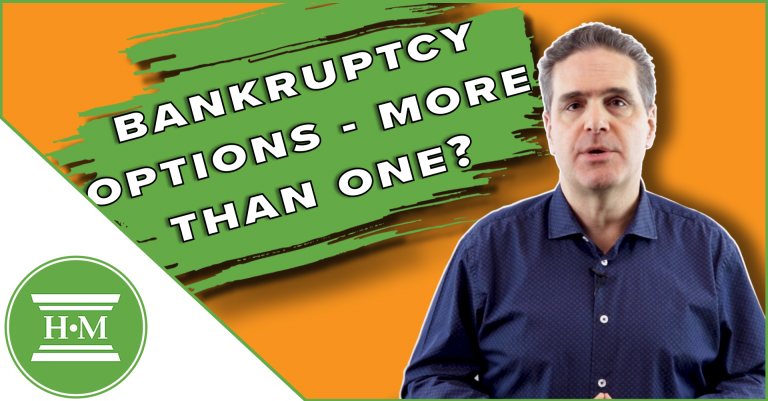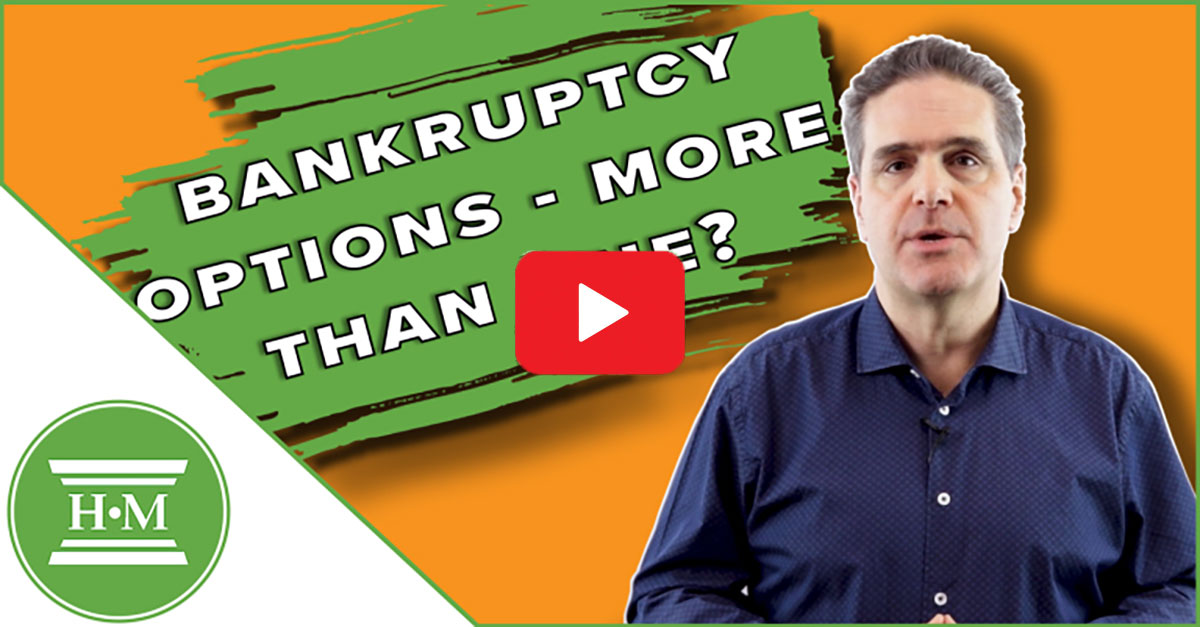
The Bankruptcy & Insolvency Act defines the legal options where an individual, or company, can be relieved of their obligation to repay debt.
In Canada, there are 4 common bankruptcy options:
- Personal bankruptcy for individuals and small businesses;
- Business bankruptcy for incorporated companies;
- Consumer proposal for individuals whose debts, excluding their mortgage, are less than $250,000;
- Division I proposal for both businesses, and individuals with debts over $250,000.
All bankruptcy options under the Bankruptcy & Insolvency must be filed with a Licensed Insolvency Trustee.
You may have heard of a Chapter 7 bankruptcy and Chapter 13 bankruptcy. These are bankruptcy options available in the United States only. Chapter 7 which is like filing personal bankruptcy in Canada and Chapter 13 which is like a consumer proposal.

In Canada, the Bankruptcy and Insolvency Act defines the legal options for a person or a company to be relieved of their debts. I’m Doug Hoyes, a Licensed Insolvency Trustee with Hoyes Michalos. As an LIT, I deal with individuals struggling with debt. So today I’m going to explain the bankruptcy options available for people in need of debt help. Those options can be split into 3 types of proceedings. Personal bankruptcy for individuals or small businesses, a consumer proposal for individuals whose debts, not including the mortgage on their home, are $250,000 or less and a Division One proposal for individuals or corporations with very large debts. All of these debt options must be filed with a Licensed Insolvency Trustee. Personal bankruptcy is a legal process where a debtor gives up his or her assets and performs certain duties in exchange for a discharge from their debts. Those duties involve surrendering any non-exempt assets, making your required monthly payments and attending 2 credit counselling sessions. Most personal bankruptcies in Canada last 9 months, for a first time bankrupt with no required surplus income payments. While most bankruptcies last only 9 months, if your income is high your bankruptcy will last longer and cost more. In this case you can chose an alternative approach under the Bankruptcy and Insolvency Act called a consumer proposal. While still filed with a Licensed Insolvency Trustee a consumer proposal is a deal you make with your creditors to repay a portion of what you owe. A consumer proposal is a legal debt settlement program sanctioned by the federal government. A consumer proposal provides the same creditor protection as filing bankruptcy does, yet you are not filing bankruptcy. You’re entering into a proposal arrangement. Consumer proposals can only be filed by individuals not corporations. To be eligible your debts, not including the mortgage on your principal residence, must be less than $250,000. Your duties in a consumer proposal are similar to a bankruptcy. You make your agreed upon payments and you attend 2 credit counselling sessions. However, with a consumer proposal you retain ownership and control of your assets. This brings us to the least common bankruptcy proceedings for Canadians, a Division One proposal. This is much like a consumer proposal, you make an offer to your creditors, but it’s designed for high debt insolvencies. Most often it would be because of high tax debts or lawsuits. We’ve talked a lot about how personal bankruptcies and consumer proposals are for individuals and not companies. It’s important to know that someone operating as a small business owner or a contractor or a self-employed person is not automatically a corporation, which means if they need to be discharged from debt, they would file personal bankruptcy or a consumer proposal. So, which type of bankruptcy should you file? Ask a Licensed Insolvency Trustee. A Licensed Insolvency Trustee will review your assets, your income and your debts with you at your initial consultation, they’ll explain what type of bankruptcy or proposal makes sense for you in your circumstances. For more information on any of these types of bankruptcies go to hoyes.com and search bankruptcy options.
Table of Contents
Personal Bankruptcy
Personal bankruptcy is a legal process where a debtor surrenders all non-exempt assets and makes specified monthly bankruptcy payments to the trustee, in exchange for which they are discharged from having to repay dischargeable unsecured debts.
The minimum threshold debt to file bankruptcy in Canada is quite low, only $1,000. However, to be eligible for bankruptcy relief you must also be insolvent. Basically, this means you are unable to repay your debts. If you can afford to repay that old credit card bill, bankruptcy is not the solution. However if you carry several thousand in consumer debt like credit cards, payday loans and you have no hope of repaying that amount in full, then bankruptcy is worth exploring.
Most personal bankruptcies last 9 months for a first-time bankrupt with no required surplus income payments. The length of bankruptcy will be extended to 21 months if an individual earns an income above the threshold limit set by the federal government.
If you have high surplus income, or may lose significant assets if you file an assignment in bankruptcy, you can opt for the second option available to individuals needing debt relief: a consumer proposal.
Consumer Proposal
A consumer proposal is an alternative procedure available through a Licensed Insolvency Trustee that provides the same legal benefits as claiming bankruptcy:
- Protection from creditor actions through a legal stay of proceeding
- Forgiveness of unsecured debt upon discharge or completion
The main advantages of a consumer proposal vs bankruptcy are that the debtor keeps all assets and, because payments can be spread out over a period of up to five years, monthly payments are much more affordable.
To qualify for a consumer proposal, your total personal debts, excluding the mortgage on a principal residence, cannot exceed $250,000. If your debts exceed this amount, you can still make a proposal to creditors through a process known as a Division I proposal.
Division I Proposal
Like a consumer proposal, a Division I proposal is a negotiated debt settlement arrangement made between a debtor and a creditor. A Division I proposal can be filed by businesses and individual’s who debts exceed $250,000.
There are also some administrative differences between a consumer proposal vs division I proposal. For an individual, the biggest consequence of filing a division I proposal is that you are automatically deemed to be bankrupt if the proposal is rejected. This is not the case with a rejected consumer proposal where the individual can choose to file bankruptcy, make another consumer proposal or continue to deal with creditors on their own.
Business Bankruptcy
There is occasionally confusion over what constitutes a business bankruptcy. In Canada, a sole-proprietor, self-employed contractor, or partner in an unlimited partnership files personal bankruptcy to deal with both business debts and personal debts.
Only corporations can file a corporate bankruptcy or can be petitioned into bankruptcy by a creditor. While a Licensed Insolvency Trustee is appointed to administer a corporate bankruptcy, most business bankruptcies also require the involvement of a bankruptcy lawyer to deal with any court issues that arise. Personal bankruptcies seldom require an individual to attend at court, and even most court hearings when they do occur are attended solely by the bankruptcy and the trustee.
If can’t afford to pay your debts, talk to a Licensed Insolvency Trustee about your situation. A trustee will explain not only your bankruptcy options, but review all alternatives to bankruptcy to ensure that the debt relief solution you choose is the right one for you.






